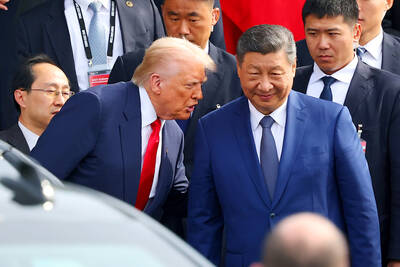Eastern China yesterday braced for torrential downpours from Typhoon Soulik which forced the evacuation of half a million people.
Soulik lashed China’s Fujian Province with winds of 118kph when it made landfall, but had weakened to a tropical depression as it moved inland, the China Meteorological Administration said.
More than half a million people were evacuated from Fujian and Zhejiang provinces as the typhoon approached, with 5,500 soldiers deployed to carry out relief work if needed.
Xinhua news agency said almost 31,000 ships were called back to port and 20 flights canceled.
Soulik brought torrential rain to Xiamen, with 24cm of rain falling on the port city from Saturday to yesterday.
Rivers swelled beyond warning levels in some areas, and waves up to 10m high pounded sea defenses in Ningde City.
While Soulik wrought havoc in Taiwan, eastern China escaped its full force.
“Billboards have been shattered and trees have been uprooted,” but no deaths or injuries were reported, Xinhua said.
Officials were calculating the cost of the storm, with the Zhejiang city of Wenzhou alone facing a direct economic loss of 210 million yuan (US$34 million), the agency said.
The storm was set to dump up to 18cm of rain on eastern parts of the country over 24 hours as it moved further inland, forecasters said.
Downpours have already hit wide swathes of China over the past week, leaving dozens dead in rain-triggered landslides.
Xinhua reported that a group of Vietnamese tourists who became trapped by a landslide in Gansu Province amid the week-long storms that have killed at least 89 people have reached a major town yesterday.
At least 100 tourists, including the 38 Vietnamese, were trapped on Friday night in after a landslide cut off traffic, the state news agency said.
They were en route to a nature reserve in Sichuan Province, which has been hit the hardest by the storms, and had reached accommodation by later that night following road repair work to free them.
They finally arrived in the central city of Xian yesterday morning, but have canceled their travel plans, Xinhua said, citing local authorities.
A man on duty at the Xian City Government Office said he had no information to give.
The whereabouts of the remaining tourists was unknown.
Meanwhile, a collapsed dam triggered a flood at a scenic spot in the southern province of Guangxi in the afternoon, killing eight tourists and injuring five others, Xinhua reported.
Authorities were searching for an unknown number of missing. It was unclear whether the dam collapsed as a result of the storms.
Sichuan has reported at least 48 storm-related deaths over the past week.
A massive mudslide that struck a scenic resort outside the city of Dujiangyan on Wednesday killed 43 people.
Flooding in the province was the worst in 50 years for some areas, with more than 220,000 people forced to evacuate.
Mudslides and flooding are common in China’s mountainous areas, killing hundreds of people every year.
In the northwest province of Shaanxi, 26 people died in landslides or house collapses.
At least 12 workers were killed in the northern province of Shanxi when a violent rainstorm collapsed an unfinished coal mine workshop.
Another three people were drowned in a car in Hebei Province outside Beijing.

CALL FOR SUPPORT: President William Lai called on lawmakers across party lines to ensure the livelihood of Taiwanese and that national security is protected President William Lai (賴清德) yesterday called for bipartisan support for Taiwan’s investment in self-defense capabilities at the christening and launch of two coast guard vessels at CSBC Corp, Taiwan’s (台灣國際造船) shipyard in Kaohsiung. The Taipei (台北) is the fourth and final ship of the Chiayi-class offshore patrol vessels, and the Siraya (西拉雅) is the Coast Guard Administration’s (CGA) first-ever ocean patrol vessel, the government said. The Taipei is the fourth and final ship of the Chiayi-class offshore patrol vessels with a displacement of about 4,000 tonnes, Lai said. This ship class was ordered as a result of former president Tsai Ing-wen’s (蔡英文) 2018

UKRAINE, NVIDIA: The US leader said the subject of Russia’s war had come up ‘very strongly,’ while Jenson Huang was hoping that the conversation was good Chinese President Xi Jinping (習近平) and US President Donald Trump had differing takes following their meeting in Busan, South Korea, yesterday. Xi said that the two sides should complete follow-up work as soon as possible to deliver tangible results that would provide “peace of mind” to China, the US and the rest of the world, while Trump hailed the “great success” of the talks. The two discussed trade, including a deal to reduce tariffs slapped on China for its role in the fentanyl trade, as well as cooperation in ending the war in Ukraine, among other issues, but they did not mention

Japanese Prime Minister Sanae Takaichi yesterday lavished US President Donald Trump with praise and vows of a “golden age” of ties on his visit to Tokyo, before inking a deal with Washington aimed at securing critical minerals. Takaichi — Japan’s first female prime minister — pulled out all the stops for Trump in her opening test on the international stage and even announced that she would nominate him for a Nobel Peace Prize, the White House said. Trump has become increasingly focused on the Nobel since his return to power in January and claims to have ended several conflicts around the world,

GLOBAL PROJECT: Underseas cables ‘are the nervous system of democratic connectivity,’ which is under stress, Member of the European Parliament Rihards Kols said The government yesterday launched an initiative to promote global cooperation on improved security of undersea cables, following reported disruptions of such cables near Taiwan and around the world. The Management Initiative on International Undersea Cables aims to “bring together stakeholders, align standards, promote best practices and turn shared concerns into beneficial cooperation,” Minister of Foreign Affairs Lin Chia-lung (林佳龍) said at a seminar in Taipei. The project would be known as “RISK,” an acronym for risk mitigation, information sharing, systemic reform and knowledge building, he said at the seminar, titled “Taiwan-Europe Subsea Cable Security Cooperation Forum.” Taiwan sits at a vital junction on